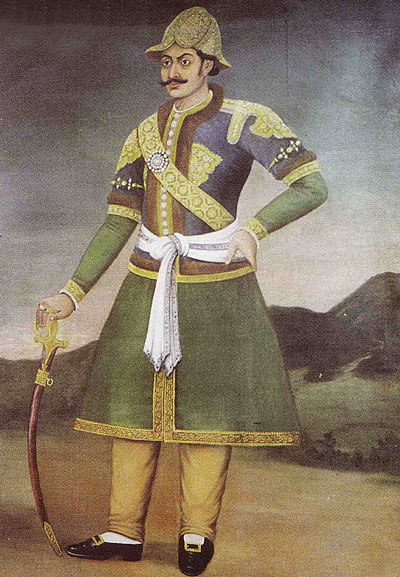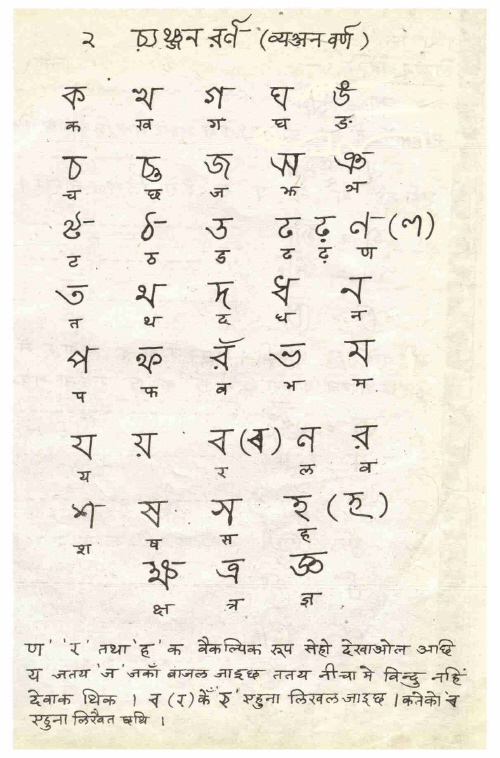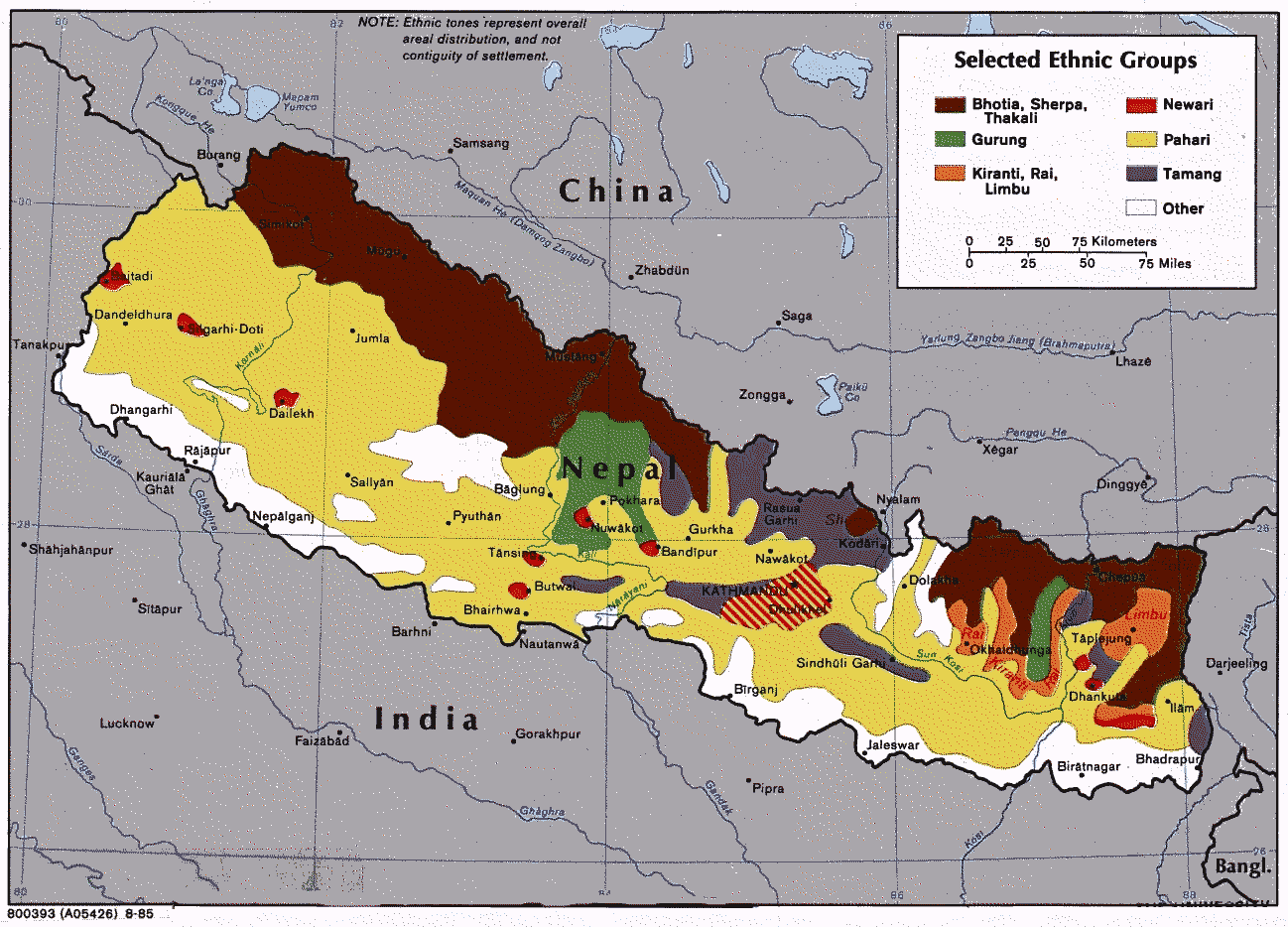|
Humla District
Humla District (), a part of Karnali Province, is one of the seventy-seven districts of Nepal. The district, with Simikot as its district headquarters, covers an area of and has population of 50,858 as per the census of 2011. Namkha is the largest rural municipal which lies in humla Humla is the 2nd largest district (by area) of Nepal. The southern and middle parts of Humla District are inhabited by Khas communities, originating from Sinja valley, whereas the higher and northern parts of Humla are mostly inhabited by culturally Tibetan communities. Nature Wild yaks were once thought to be regionally extinct in Nepal, but was rediscovered in Humla in 2014. Demographics At the time of the 2011 Nepal census, Humla District had a population of 50,858. As first language, 87.3% spoke Nepali language, Nepali, 12.1% Tamang language, Tamang, 0.1% Magar language, Magar, 0.1% Maithili language, Maithili, 0.1% Sign language and 0.3% other languages. Ethnicity/caste: 47.9% were Khas/Ch ... [...More Info...] [...Related Items...] OR: [Wikipedia] [Google] [Baidu] |
Districts Of Nepal
Districts in Nepal are second level of administrative divisions after provinces. Districts are subdivided into municipalities and rural municipalities. There are seven provinces and 77 districts in Nepal. After the 2015 reform of administrative divisions, Nawalparasi District and Rukum District were respectively divided into Parasi District and Nawalpur District, and Eastern Rukum District and Western Rukum District. District officials District official include: * Chief District Officer, an official under Ministry of Home Affairs is appointed by the government as the highest administrative officer in a district. The C.D.O is responsible for proper inspection of all the departments in a district such as health, education, security and all other government offices. * District Coordination Committee acts as an executive to the District Assembly. The DCC coordinates with the Provincial Assembly to establish coordination between the Provincial Assembly and rural muni ... [...More Info...] [...Related Items...] OR: [Wikipedia] [Google] [Baidu] |
Montane Ecology
Montane ecosystems are found on the slopes of mountains. The alpine climate in these regions strongly affects the ecosystem because temperatures fall as elevation increases, causing the ecosystem to stratify. This stratification is a crucial factor in shaping plant community, biodiversity, metabolic processes and ecosystem dynamics for montane ecosystems. Dense montane forests are common at moderate elevations, due to moderate temperatures and high rainfall. At higher elevations, the climate is harsher, with lower temperatures and higher winds, preventing the growth of trees and causing the plant community to transition to montane grasslands and shrublands or alpine tundra. Due to the unique climate conditions of montane ecosystems, they contain increased numbers of endemic species. Montane ecosystems also exhibit variation in ecosystem services, which include carbon storage and water supply. Life zones As elevation increases, the climate becomes cooler, due to a decrease in ... [...More Info...] [...Related Items...] OR: [Wikipedia] [Google] [Baidu] |
Kami (caste)
Kami is an Indo-Aryan Nepali speaking group that primarily worked as metalsmiths. Later Nepal abolished its grading system. The tribal designation of Khas is given in some contexts. the Government of Nepal legally abolished the caste-system and criminalized any caste-based discrimination, including " untouchability" (the ostracism of a specific caste) - in the year 1963 A.D. With Nepal's step towards freedom and equality, Nepal, previously ruled by a Hindu monarchy was a Hindu nation which has now become a secular state, and on 28 May 2008, it was declared a republic, ending it as the Hindu kingdom. In spite of being the important occupational caste and ethnic group whose metal carving arts are globally recognized but still struggling to be recognized as it is considered as the serving occupation. The most people of this caste group are in absolute poverty to raise the voice and educate themselves to be in a good position to find the history. So they are compelled to face ... [...More Info...] [...Related Items...] OR: [Wikipedia] [Google] [Baidu] |
Tibetan Tribes
Tibetan may mean: * of, from, or related to Tibet * Tibetan people, an ethnic group * Tibetan language: ** Classical Tibetan, the classical language used also as a contemporary written standard ** Standard Tibetan, the most widely used spoken dialect ** Tibetan pinyin, a method of writing Standard Tibetan in Latin script ** Tibetan script ** any other of the Tibetic languages Tibetan may additionally refer to: Culture * Old Tibetan, an era of Tibetan history * Tibetan art * Music of Tibet * Tibetan rug * Tibetan culture * Tibetan cuisine Religion * Tibetan Buddhism * Tibetan Muslims Other uses * Tibetan alphabet * Tibetan (Unicode block) * Tibetan name * Tibetan calendar * Tibetan Spaniel, a breed of dog * Tibetan Mastiff, a breed of dog See also * Tibet (other) * Tibetan Bells (other) * Traditional Tibetan medicine * Tibetan language (other) Tibetan language may refer to: * Lhasa Tibetan or Standard Tibetan, the most widely used spoken dialect * ... [...More Info...] [...Related Items...] OR: [Wikipedia] [Google] [Baidu] |
Thakuri
The Thakuri (Nepali: ठकुरी) . This term is Nepalese title ""Thakuri"", which translates to 'master of the estate'. The term denotes the royal descendants of kings of Baise Rajya and Chaubisi Rajya. During the height of their influence, the Thakuri caste played a pivotal role in shaping the political landscape of Nepal. They held positions of authority and governance, contributing to the administration and stability of the region. Their lineage was highly regarded, and they were often sought after for leadership roles within the kingdom. Notably, members of the Shah dynasty, which ruled Nepal for centuries, were descendants of the Khand Thakuri caste from Chaubisi. The Shah royal family held significant sway over Nepalese affairs, guiding the nation through various periods of prosperity and turmoil. The Thakuris forged a legacy deeply rooted in Nepalese history. Their contributions to politics, culture, and society continue to be remembered and celebrated, reflecting t ... [...More Info...] [...Related Items...] OR: [Wikipedia] [Google] [Baidu] |
Chhetri
Chhetri (Kshetri, Kshettri, Kshetry or Chhettri), ( ; IAST: ''Kṣetrī'') historically called Kshettriya or Kshetriya or Khas are Nepali language, Nepali speaking people historically associated with the warrior class and administration, some of whom trace their origin to migration from medieval India. Chhetri was a caste of administrators, governors, Bir Bhadra Thapa, warriors and military elites in the medieval Khasa kingdom, Khas Kingdom and Gorkha Kingdom (later unified Kingdom of Nepal). The nobility of the Gorkha Kingdom mainly originated from Chhetri families. They also had a strong presence in civil administration affairs. The bulk of Prime Minister of Nepal, prime ministers of Nepal before the Revolution of 1951, democratization of Nepal belonged to this caste as a result of the old Gorkhali aristocracy. Gorkha-based aristocratic Chhetri families included the Pande dynasty, the Basnyat dynasty, the Kunwar family (and their offspring branch, the autocratic Rana dynasty) an ... [...More Info...] [...Related Items...] OR: [Wikipedia] [Google] [Baidu] |
Sign Language
Sign languages (also known as signed languages) are languages that use the visual-manual modality to convey meaning, instead of spoken words. Sign languages are expressed through manual articulation in combination with #Non-manual elements, non-manual markers. Sign languages are full-fledged natural languages with their own grammar and lexicon. Sign languages are not universal and are usually not mutual intelligibility, mutually intelligible, although there are similarities among different sign languages. Linguists consider both spoken and signed communication to be types of natural language, meaning that both emerged through an abstract, protracted aging process and evolved over time without meticulous planning. This is supported by the fact that there is substantial overlap between the neural substrates of sign and spoken language processing, despite the obvious differences in modality. Sign language should not be confused with body language, a type of non verbal communicati ... [...More Info...] [...Related Items...] OR: [Wikipedia] [Google] [Baidu] |
Maithili Language
Maithili ( , ) is an Indo-Aryan language spoken in parts of India and Nepal. It is native to the Mithila region, which encompasses parts of the eastern Indian states of Bihar and Jharkhand as well as Nepal's Koshi Province, Koshi and Madhesh Provinces. It is one of the 22 scheduled languages of India. It is the second most commonly spoken native languages of Nepal, Nepalese language constitutionally registered as one of the fourteen provincial official languages of Nepal. It is spoken by 21.7 million people. Of those, 3.2 million are Nepalis, Nepalese speakers. The language is predominantly written in Devanagari, but the historical Tirhuta script, Tirhuta and Kaithi scripts retained some use until today. Official status In 2003, Maithili was included in the 8th Schedule, Eighth Schedule of the Indian Constitution as a recognised language of India, Indian language, which allows it to be used in education, government, and other official contexts in India. The Maithili language i ... [...More Info...] [...Related Items...] OR: [Wikipedia] [Google] [Baidu] |
Magar Language
Magar Dhut (, ) is a Sino-Tibetan language spoken mainly in Nepal, southern Bhutan, and in Darjeeling, Assam and Sikkim, India, by the Magar people. It is divided into two groups (Eastern and Western) and further dialect divisions give distinct tribal identity. In Nepal 810,000 people speak the language. While the government of Nepal developed Magar language curricula, as provisioned by the constitution, the teaching materials have never successfully reached Magar schools, where most school instruction is in the Nepali language. It is not unusual for groups with their own language to feel that the "mother-tongue" is an essential part of identity. The Dhut Magar language is sometimes lumped with the Magar Kham language spoken further west in Bheri, Dhaulagiri, and Rapti zones. Although the two languages share many common words, they have major structural differences and are not mutually intelligible. Geographical distribution Western Magar Western Magar (dialects: ''Pal ... [...More Info...] [...Related Items...] OR: [Wikipedia] [Google] [Baidu] |
Tamang Language
Tamangic language is spoken mainly in Tamangsaling Land in Nepal, Sikkim, West Bengal (Darjeeling) and North-Eastern India. It comprises Eastern Tamang, Northwestern Tamang, Southwestern Tamang, Eastern Gorkha Tamang, and Western Tamang. Lexical similarity between Eastern Tamang (which is regarded as the most prominent) and other Tamang languages varies between 81% and 63%. For comparison, the lexical similarity between Spanish and Portuguese is estimated at 89%. Ethnologue report for Spanish Dialects ''Ethnologue'' divides Tamang into the following varieties due to mutual unintelligibility. *Eastern Tamang: 759,000 in Nepal (2000 WCD). Population total all countries: 773,000. Sub-dialects are as follows. **Outer-Eastern Tamang (Sailung Tamang) **Central-Eastern Tamang (Temal Tamang) **Southwestern Tamang (Kath-Bhotiya, Lama Bhote, Murmi, Rongba, Sain, Tamang Gyoi, Tamang Gyot, Tamang Lengmo, Tamang Tam) *Western Tamang: 323,000 (2000 WCD). Sub-dialects are as follows. ** ... [...More Info...] [...Related Items...] OR: [Wikipedia] [Google] [Baidu] |
Nepali Language
Nepali (; , ), or ''Gorkhali'' is an Indo-Aryan languages, Indo-Aryan language native to the Himalayas region of South Asia. It is the official and most widely spoken Languages of Nepal, language of Nepal, where it also serves as a ''lingua franca''. Nepali has Languages with official status in India, official status in the Indian state of Sikkim and in the Gorkhaland Territorial Administration of West Bengal. It is spoken by about a quarter of Bhutan's population. Nepali also has a significant number of speakers in the Indian states of Arunachal Pradesh, Assam, Himachal Pradesh, Manipur, Meghalaya, Mizoram and Uttarakhand. In Myanmar it is spoken by the Burmese Gurkhas. The Nepali diaspora in the Middle East, Brunei, Australia and worldwide also use the language. Nepali is spoken by approximately 19 million native speakers and another 14 million as a second language. Nepali is commonly classified within the Eastern Pahari group of the Northern Indo-Aryan languages, Northern zo ... [...More Info...] [...Related Items...] OR: [Wikipedia] [Google] [Baidu] |
2011 Nepal Census
Nepal conducted a widespread national census in 2011 by the Nepal Central Bureau of Statistics. Working in cooperation with the 58 municipalities and the 3,915 Village Development Committees at a district level, they recorded data from all the municipalities and villages of each district. The data included statistics on population size, households, sex and age distribution, place of birth, residence characteristics, literacy, marital status, religion, language spoken, caste/ethnic group, economically active population, education, number of children, employment status, and occupation. *Total population in 2011: 26,494,504 *Increase since last census in 2001: 3,343,081 *Annual population growth rate (exponential growth): 1.35 * ... [...More Info...] [...Related Items...] OR: [Wikipedia] [Google] [Baidu] |





